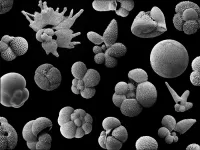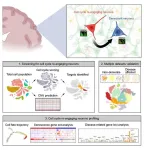(Press-News.org) For hundreds of millions of years, the oceans have teemed with single-celled organisms called foraminifera, hard-shelled, microscopic creatures at the bottom of the food chain. The fossil record of these primordial specks offers clues into future changes in global biodiversity, related to our warming climate.
Using a high-resolution global dataset of planktonic foraminifera fossils that’s among the richest biological archives available to science, researchers have found that major environmental stress events leading to mass extinctions are reliably preceded by subtle changes in how a biological community is composed, acting as a pre-extinction early warning signal.
The results are in Nature, co-led by Anshuman Swain, a Junior Fellow in the Harvard Society of Fellows, researcher in the Department of Organismic and Evolutionary Biology, and affiliate of the Museum of Comparative Zoology. A physicist by training who applies networks to biological and paleontological data, Swain teamed with co-first author Adam Woodhouse at the University of Bristol to probe the global, community structure of ancient marine plankton that could serve as an early warning system for future extinction of ocean life.
“Can we leverage the past to understand what might happen in the future, in the context of global change?” said Swain, who previously co-authored a study about the formation of polar ice caps driving changes in marine plankton communities over the last 15 million years. “Our work offers new insight into how biodiversity responds spatially to global changes in climate, especially during intervals of global warmth, which are relevant to future warming projections.”
The researchers used the Triton database, developed by Woodhouse, to ascertain how the composition of foraminifera communities changed over millions of years – orders of magnitude longer time spans than are typically studied at this scale. They focused on the Early Eocene Climatic Optimum, the last major period of sustained high global temperatures since the dinosaurs, analogous to worst-case global warming scenarios.
They found that, before an extinction pulse of 34 million years ago, marine communities became highly specialized everywhere but southern high latitudes, implying that these micro-plankton migrated en masse to higher latitudes and away from the tropics. This finding indicates that community-scale changes like the ones seen in these migration patterns are evident in fossil records long before actual extinctions and losses in biodiversity occur.
The researchers thus think it’s important to place emphasis on monitoring the structure of biological communities to predict future extinctions.
According to Swain, the results from the foraminifera studies open avenues of inquiry into other organismal groups, including other marine life, sharks, and insects. Such studies may spark a revolution in an emerging field called paleoinformatics, or using large spatiotemporally resolved databases of fossil records to glean new insights into the future Earth.
The researchers’ study was made possible by a longstanding National Science Foundation field study aboard the JOIDES Resolution research vessel, which over the last 55 years has conducted ocean drilling around the world. The project is set to expire this year.
END
Marine plankton communities changed long before extinctions
2024-04-23
ELSE PRESS RELEASES FROM THIS DATE:
Research reveals tools to make STEM degrees more affordable
2024-04-23
In a new study in Issues, Dominique J. Baker, an associate professor in the College of Education and Human Development and the Joseph R. Biden, Jr. School of Public Policy & Administration at the University of Delaware, explored the role of student loans on hopeful students striving for college degrees, particularly in STEM.
The cost of attending a public four-year college in the United States has more than doubled since the early 1990s, when inflation is factored in.
Undergraduate student loan debt has become unmanageable for a wide swath of borrowers ...
Q&A: UW research shows neural connection between learning a second language and learning to code
2024-04-23
As computer programming becomes an increasingly valued skill in the workforce, there is a greater need to understand how people learn to code most effectively.
Statistics show that up to 50% of students who enroll in introductory programming courses in the United States eventually drop out, suggesting a mismatch between how coding is learned and the way it’s taught. A new study from the University of Washington, published March 5 in Scientific Reports, examines that issue.
The researchers recorded electrophysiological brain responses of varyingly skilled programmers as they read ...
Keane wins 2024 Gopal K. Shenoy Excellence in Beamline Science Award
2024-04-23
Physicist Denis T. Keane is the 2024 recipient of the Gopal K. Shenoy Excellence in Beamline Science Award. He is a beamline scientist and director of the Dupont-Northwestern-Dow Collaborative Access Team (DND-CAT) at the U.S. Department of Energy’s (DOE) Advanced Photon Source (APS) at DOE’s Argonne National Laboratory. He is also a research professor in the Materials Science and Engineering Department at Northwestern University.
The annual award recognizes active beamline scientists at the APS, ...
Livestock abortion surveillance could protect livelihoods and detect emerging global pathogens
2024-04-23
A small-scale surveillance system in Tanzania for reporting livestock abortions could help protect livelihoods and provide insights on potential livestock-to-human infections.
The research, published April 16 as a Reviewed Preprint in eLife, is described by editors as an important study with convincing findings of potential interest to the fields of veterinary medicine, public health and epidemiology.
Loss of livestock through abortion is a major concern for the worldwide livestock industry, resulting in significant ...
Optimal timing maximises Paxlovid benefits for treating COVID-19
2024-04-23
Researchers have described the optimal timing for COVID-19 patients to take the antiviral, Paxlovid, to get the most benefit from the treatment, according to a study published April 16 in eLife.
The findings suggest that taking Paxlovid three to five days after COVID-19 symptoms emerge may maximise the drug’s ability to reduce viral loads, minimise viral spread and reduce viral rebound. They also indicate that broader use of Paxlovid during this window might be a powerful tool to help curb the spread of the SARS-CoV-2 ...
IU researchers receive $4.8 million grant to study the role of misfolded protein TDP-43 in neurodegenerative diseases
2024-04-23
INDIANAPOLIS—A new $4.8 million grant will support researchers from Indiana University School of Medicine and the Medical Research Council Laboratory of Molecular Biology to study how human neurodegenerative diseases are affected by the misfolding of the protein TDP-43. Misfolding occurs when a protein adopts a conformation which differs from the native one.
The researchers, funded by the National Institute of Neurological Disorders and Stroke, have developed an innovative approach to deciphering the role of TDP-43 misfolding in the pathology ...
DOE’s Office of Science Graduate Student Research Program selects 86 outstanding US graduate students
2024-04-23
WASHINGTON, D.C. – The Department of Energy’s (DOE’s) Office of Science has selected 86 graduate students representing 31 states and Puerto Rico for the Office of Science Graduate Student Research (SCGSR) program’s 2023 Solicitation 2 cycle. Through world-class training and access to state-of-the-art facilities and resources at DOE national laboratories, SCGSR prepares graduate students to enter jobs of critical importance to the DOE mission and secures our national position at the forefront of discovery and innovation.
“The Graduate Student Research program is a unique opportunity ...
This tiny chip can safeguard user data while enabling efficient computing on a smartphone
2024-04-23
Health-monitoring apps can help people manage chronic diseases or stay on track with fitness goals, using nothing more than a smartphone. However, these apps can be slow and energy-inefficient because the vast machine-learning models that power them must be shuttled between a smartphone and a central memory server.
Engineers often speed things up using hardware that reduces the need to move so much data back and forth. While these machine-learning accelerators can streamline computation, they are susceptible to attackers who can steal secret ...
World’s chocolate supply threatened by devastating virus
2024-04-23
A rapidly spreading virus threatens the health of the cacao tree and the dried seeds from which chocolate is made, jeopardizing the global supply of the world’s most popular treat.
About 50% of the world’s chocolate originates from cacao trees in the West Africa countries of Ivory Coast and Ghana. The damaging virus is attacking cacao trees in Ghana, resulting in harvest losses of between 15 and 50%. Spread by small insects called mealybugs that eat the leaves, buds and flowers of trees, the cacao swollen shoot virus disease (CSSVD) is among the most damaging threats to the root ingredient of chocolate.
“This ...
Wake up and die: Human brain neurons re-entering the cell cycle age quickly shift to senescence
2024-04-23
Post-mitotic neurons in the brain that re-enter the cell cycle quickly succumb to senescence, and this re-entry is more common in Alzheimer’s disease, according to a new study published April 9th in the open-access journal PLOS Biology by Kim Hai-Man Chow and colleagues at the Chinese University of Hong Kong. The phenomenon may provide an opportunity to learn more about the neurodegeneration process, and the technique used to make this discovery is readily applicable to other inquiries about unique populations of cells in the brain.
Most neurons in the ...



